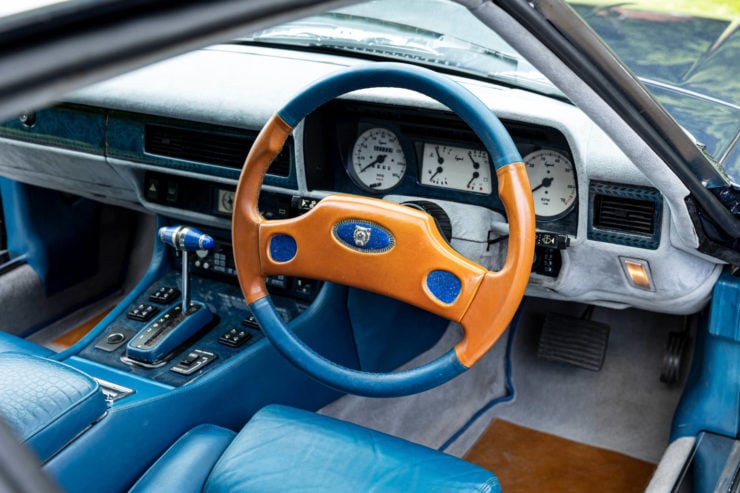It is not widely known that in the late 1980s, Gucci’s former design director Paolo Gucci worked with British coach builder Lynx to create a limited production of 20 Jaguar XJS shooting brakes.
The car here was the first prototype. It was born as Lynx Eventer, the company’s shooting break version of XJS V12. Paolo Gucci pays close attention to details such as blue lacquered bar elm woodwork, Italian calfskin upholstery and semi-precious lapis lazuli stone.
Tips-Jaguar XJS V12 by Paolo Gucci
- The Jaguar XJS was released in 1975 as a successor to the Jaguar E-Type. In 1982, British car body manufacturing and customization company Lynx developed its own shooting break version of the XJS.
- This car, called the Lynx Eventer, had a classic shooting brake design with two doors and the rear end of the estate car. It is designed to allow gentleman hunters to place their guns while hunting.
- Paolo Gucci, a former design director of Gucci, lived in England with his English wife in the 1980s. He clearly liked the Links Iventer because he worked with his company to create his own “Gucci” version.
- The original plan was to build 20 pieces and sell them for £ 100,000 each. The first prototype was completed and unveiled to the world at the 1990 Geneva Motor Show, but Gucci dispatched a lawyer to shut down the project within 24 hours.
Paolo Gucci
In all accounts, Paolo Gucci was a charismatic Italian who was bigger than the person in life and looked at both style and quality. He was well suited for his role as Gucci’s Design Director and Vice President – the role he served for 20 years.


“After spending 20 years as Gucci’s design director and product coordinator, I am now bringing my knowledge and talent to the wider consumer market.”
“Now I’m going to design entirely in my name and add my personality and style. With my” Florence “tradition, my enthusiasm, enthusiasm and dedication to quality, the discerning consumer We hope to continue to provide the best design for you. – – Paolo Gucci
Paolo Gucci married Jenny Garwood, a British social celebrity with two children, in 1977, after the first marriage broke down. He spent a lot of time in England. This could be the first place I saw LynxEventer after it was published in 1982.
Within a few years, he was working on his own version of the eventer, the “Paolo Gucci” version. It was planned to be produced in 20 series with a price tag of £ 100,000.
He wasn’t officially working for Gucci at this point, so when the car was unveiled at the 1990 Geneva Motor Show, Gucci’s lawyers didn’t waste time shutting down the project.


Within 24 hours, all Gucci brands on the car were removed and rebranded with the original Lynx logo. Sadly, perhaps for obvious reasons, the planned production execution did not happen and Paolo moved on to something else.
The car was later sold to David Andrew Richards, but it seems that it remained near Paolo Gucci’s heart as he later tried to buy it back.
Links Iventer
Founded in 1968, Lynx was originally conceived as a repair and tuning shop specializing in Jaguar C-Type and Jaguar D-Type.
Once the reputation was established, the company developed its own take of D-Type. It is built using more modern E-Type running gear. This car was launched in 1975 and was named Lynx D-Type.


These Lynx D-Types are now worth a lot and are considered classics in their own right.
After the release of Jaguar XJS in 1975, the Lynx team closed the market gap by offering a convertible version that Jaguar didn’t offer at the time. Later, when it became clear that Jaguar would release its own open-top version, Lynx announced the latest shooting brake, Eventer.
The elegant styling of the Lynx Eventer has long been admired, and some consider it to look better than the standard XJ on which it is based. This car was immediately popular with all the right types of people. One of them was Paolo Gucci, who was talking about the above.
Today, many surviving Lynx eventers make daily drivable classics that are popular with those who can afford them. I don’t think many are still used for hunting purposes, but you really don’t know.
Paolo Gucci Jaguar XJS shown here
The car displayed here is the one and only Paolo Gucci XJS. Furthermore, as mentioned above, this car is a prototype of the planned 20 car production, each car being styled by Gucci’s former design director Paolo Gucci.


Many changes made to this car include blue lacquered bar elm woodwork with inlaid chevron crossbanding, modified instruments, hand-dyed Italian calfskin upholstery, and crocodile effect leather on the armrests. Includes blue stained glass ash door handles and Alcantara suede headlining.
The steering wheel features hand-sewn leather and is inlaid with semi-precious lapis lazuli stones. These stones are also fitted into the gear knobs. The car was completed with carpeted boots and a one-time woven jaguar motif.
After the turbulent early life at the 1990 Geneva Motor Show, which raged Gucci’s legal department, the car was sold to individuals. Further, as mentioned above, Paolo Gucci himself later tried to buy it back for his own personal use.
We will be presenting a price guide of £ 70,000-100,000, or about $ 86,200-123,100 across the auction block with Bonhams on June 24th. If you want to read more about it or register to bid, you can visit the list here.













Image courtesy of Bonhams

Ben has featured on CNN, Popular Mechanics, Smithsonian Magazine, Road & Track Magazine, Pinterest’s official blog, eBay Motors’ official blog, BuzzFeed and more.
Silodrome was founded by Ben in 2010. The site has grown to become a global leader in the alternative and vintage automotive sector, with millions of readers worldwide and hundreds of thousands of followers on social media.
